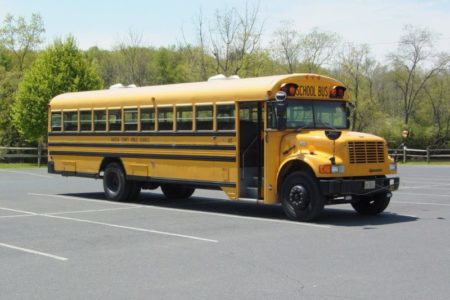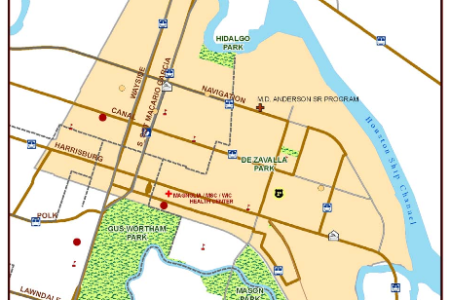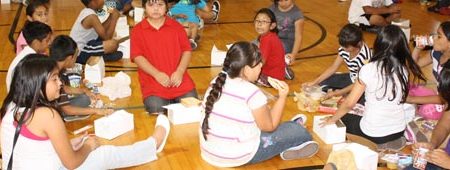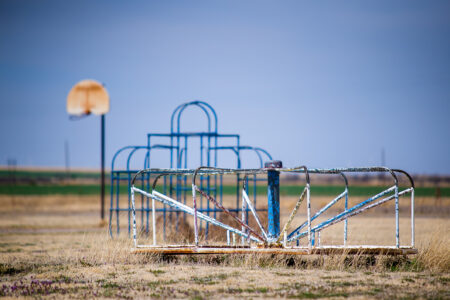Share On Social!
Thanks to a partnership between Children and Neighbors Defeat Obesity (CAN DO) Houston, the Houston Parks and Recreation Department (HPARD), and the Houston Independent School District (HISD), students at Briscoe Elementary School in Houston now have new opportunities for the active play they need to ensure health and prevent childhood obesity. Before the collaboration, parents identified a lack of physical activity as a primary health concern; now thanks to an after school busing program, students can attend after-school activities at a nearby park for free.
EMERGENCE
Awareness: In 2005, the 44% Latino city of Houston was named America’s fattest city by Men’s Fitness magazine, prompting the formation of the Mayor’s Wellness Council (MWC) and later the Houston Wellness Association (HWA).

At the time, about half of Houston’s kids were overweight or obese, more so in minority communities.
It was through MWC and HWA meetings that stakeholders began to discuss childhood obesity and the possibility of coordinating efforts by using existing resources to reduce and prevent the issue.
Eventually, in February 2008, these discussions led to the creation of CAN DO Houston—a non-profit organization that aims to reduce childhood obesity by using a community-based, collaborative approach to generate environmental and systems changes.
The CAN DO executive director was Beverly Gor, a registered dietician and native Houstonian working in the field of public health.
Gor was well aware of the challenges faced by local underserved residents: limited access to recreational facilities, few after-school fitness programs, and limited availability of fresh produce. She also knew that children living under these conditions were more likely to be at risk for becoming overweight or obese.

Learn/Frame Issue: In 2003, the city of Houston had identified 88 super neighborhoods—geographically designated areas where communities could collaborate to improve the quality of life for Houston residents. The super neighborhood elects a council comprised of area residents and stakeholders that serves as a forum to discuss issues and identify and implement priority projects for the area.
With this data and support from the Center for Clinical and Translational Sciences (CCTS) and the Houston Department of Health and Human Services (HDHHS), CAN DO identified two super neighborhoods (Magnolia Park and Sunnyside) as potential sites for a health improvement.
CAN DO studied the demographics of each region by examining census data, crime maps, and HDHHS assessment, intervention, mobilization (AIM) data. In Magnolia Park, a predominantly Latino neighborhood (97.7%), residents faced high rates of poverty and low levels of educational attainment. AIM data showed that 45.5% of Magnolia Park’s residents had less than a ninth-grade education and that the neighborhood had the lowest amount of high-school graduates.
CAN DO focused in on Magnolia Park, particularly targeting Briscoe Elementary School in the Houston Independent School District (HISD), as a potential hub for community meetings, education, information dissemination and pilot health projects. The HDHHS had formed a relationship with Juan Gonzalez, Briscoe principal, motivating CAN DO to approach Gonzalez to learn about any problems facing the school.
On the positive side, Briscoe already had the Coordinated Approach to Child Health (CATCH) curriculum and had successfully implemented a Recipe for Success program.
On the negative side, Gonzalez told CAN DO he was concerned about the lack of physical activity opportunities for his students. During after school hours, he said children were not going outside to play because parents were concerned about their safety.
CAN DO officials decided to find ways to remedy the school’s lack of after-school physical activity programs.
DEVELOPMENT
Education/Mobilization: In May of 2008, Gor met with parents, teachers, and Gonzalez to hear what they had to say about the barriers that kept them and their children from leading a healthy lifestyle.
Parents identified concerns about park safety and crime in the area. Principal Gonzalez expressed a need for a second physical education (P.E.) teacher, more physical activity programs, and a staff wellness program.
“CAN DO was trying to bring to light the obesity issue and one thing that they found was the lack of exercise,” Gonzalez said. “So they volunteered their services at no cost.”
After listening to what the community had to say, CAN DO approached Gonzalez with the idea of bringing an after-school physical activity program to students at Briscoe. They explained that a program like this would support the CATCH and Recipe for Success initiatives already occurring at Briscoe.
CAN DO also sought ways to increase after-school programs outside of school in the community.
They found out that Mason Park, a city park less than a half-mile from Briscoe, offered free after-school physical activity programming to students.
But few kids joined the programs, according to Houston Parks and Recreation Department (HPARD).
CAN DO spoke to parents and found that safety concerns and that a lack of transportation kept many Briscoe students from participating in the park’s free programming.
Debate: CAN DO officials, recognizing that a second P.E. teacher would help increase time students spent in PE class, as Principal Gonzalez had suggested, concluded that paying for a new teacher’s salary would be too costly.
Instead, they wanted to provide teachers with a 30-minute training session and a workbook on how to incorporate physical activity breaks throughout the school day.
ENACTMENT
Activation: CAN DO worked with HPARD to pilot-test a seven-week physical activity program at Briscoe.
HPARD agreed to send staff to Briscoe to lead after-school physical activity programs. CAN DO Houston agreed to provide fitness equipment, train teachers to incorporate physical activity into their classrooms, and to provide assistance with after-school programs in partnership with Mason Park.
During the 2008-2009 school year, 80 kids enrolled in after-school soccer, kickball, relay races, and other programming offered at Briscoe. At the end of the seven-week pilot period, HPARD continued to offer a weekly soccer program to about 40 Briscoe students.
Most of the after-school programming didn’t become a permanent fixture, Gor said.
While planning for the next school year, during one of CAN DO’s quarterly meetings, Gor explained to stakeholders that HPARD was offering free physical activity to students at nearby Mason Park.
Gor said that, despite being a less than half-mile from the school, walking was not safe due to the high traffic caused by a four-lane road that separates Briscoe and Mason Park.
“It became apparent that the lack of transportation to Mason Park had been a barrier which kept children from participating in after school programs,” Gor said.
Evelyn Henry, a CAN DO board member and director of medical services for HISD at the time, suggested that HISD provide busing for students interested in attending after school activities at Mason park.
“Parents believed that [their children] would not be safe walking,” Gonzalez said. “So we came up with the idea of buses.”
Frame Policy: Because HPARD and CAN DO had built trust with Briscoe parents through the pilot after-school programs, Gor believed parents would feel more comfortable sending their children to after-school activities at Mason Park—if the district could provide a means of safe transportation to students.
Briscoe students’ good attendance in the pilot programs also showed their demand for such programming.
The district was willing to support Briscoe students with bus transportation to Mason Park twice a week.
Change: According to Gor, Henry identified some discretionary funds from the district that could make the busing initiative possible.
CAN DO and HISD then drafted a one-year services agreement specifying that HISD would support after-school programs at Briscoe in partnership with Mason Park by providing bus transportation for students twice a week.
The bus program was launched in the 2009-2010 school year and Briscoe students were able to attend after school programming offered at Mason Park from 3-6 p.m. on Wednesdays and Thursdays.
IMPLEMENTATION

Implementation: For the first year, the bus from Briscoe to Mason Park carried only a few students.
But as more parents learned about the busing initiative, the number of students on the bus increased and soon all the seats on the bus were occupied by students.
Today, about 35 students now attend after-school physical activity and enrichment programming at Mason Park. When they first arrive, students get time to complete homework and a meal, which is provided through funding from the Texas Department of Agriculture Child and Adult Care Food Program (CACFP). Then students can participate in soccer, baseball, kickball, or frisbee.
Equity: Because, the busing program has been in full effect for five years and the demand continues to grow, Gor spoke with the Gwendolyn Johnson, HISD’s new director of medical services, to see if an additional day of bus transportation to Mason Park could be offered to students at Briscoe.
Johnson agreed to expand the program on the condition that CAN DO helps the district evaluate the effectiveness of the program.
“We have to be accountable for the services we are providing,” Gor said. CAN DO is currently looking at working with HISD to conduct Fitnessgram assessments, acanthosis nigricans screenings (a skin manifestation of insulin resistance usually observed on the neck), and to collect information on student behavior. “We just had a meeting with our partners to discuss what type of data we can collect to measure the effectiveness of this initiative.”
Briscoe indeed went ahead and expanded the busing to a third day, Fridays.
According to Gonzalez, CAN DO’s support has provided students, parents, and teachers with more options to be healthy.
“We have seen that children who are more active tend to perform better,” Gonzalez said. “Now, Briscoe offers a variety of health related activities not only to students, but also to parents. Activities like Fitness Friday and Zumba classes are available at Briscoe.”
CAN DO has also worked at Briscoe in partnership with Recipe for Success, to teach students about growing, cooking, and eating healthy vegetables.
Sustainability: According to Gor, CAN DO is still looking to find ways to ensure that students from Briscoe continue to participate in the after school activities offered at Mason Park.
One avenue they are considering is finding a way to develop a bridge which would allow children to cross a nearby bayou and arrive safely to Mason Park, without busing.
Additional Links:
CAN DO Program-Services Contract with the Houston Independent School District
CDC Case Study on CAN DO
Geographic Profiles for Super neighborhoods
Updates from CAN DO about Magnolia Park
Screening requirements for Acanthosis Nigricans in Texas
This success story was produced by Salud America! with support from the Robert Wood Johnson Foundation.
The stories are intended for educational and informative purposes. References to specific policymakers, individuals, schools, policies, or companies have been included solely to advance these purposes and do not constitute an endorsement, sponsorship, or recommendation. Stories are based on and told by real community members and are the opinions and views of the individuals whose stories are told. Organization and activities described were not supported by Salud America! or the Robert Wood Johnson Foundation and do not necessarily represent the views of Salud America! or the Robert Wood Johnson Foundation.
ABOUT THE PROGRAM
Salud America! The RWJF Research Network to Prevent Obesity Among Latino Children is a national program of the Robert Wood Johnson Foundation. The program aims to educate researchers, decision-makers, community leaders, and the public in contributing toward healthier Latino communities and seeking environmental and policy solutions to the epidemic of Latino childhood obesity. The network is directed by the Institute for Health Promotion Research at the University of Texas Health Science Center at San Antonio.
For more information, visit http://www.salud-america.org.
By The Numbers
33
percent
of Latinos live within walking distance (<1 mile) of a park
This success story was produced by Salud America! with support from the Robert Wood Johnson Foundation.
The stories are intended for educational and informative purposes. References to specific policymakers, individuals, schools, policies, or companies have been included solely to advance these purposes and do not constitute an endorsement, sponsorship, or recommendation. Stories are based on and told by real community members and are the opinions and views of the individuals whose stories are told. Organization and activities described were not supported by Salud America! or the Robert Wood Johnson Foundation and do not necessarily represent the views of Salud America! or the Robert Wood Johnson Foundation.



